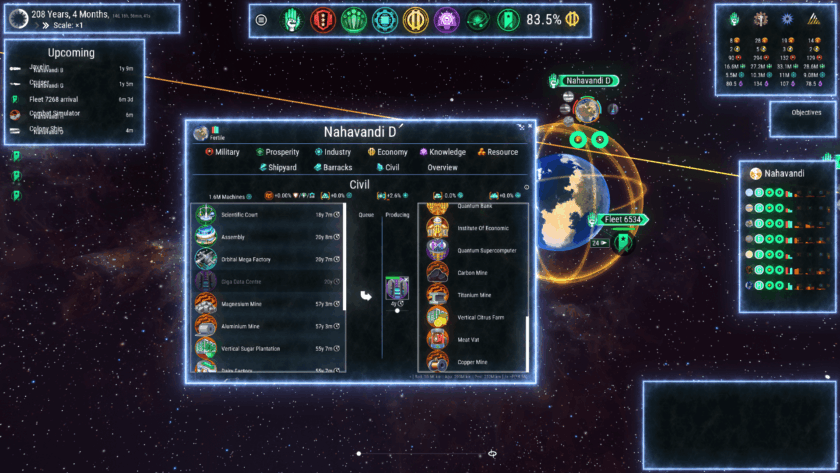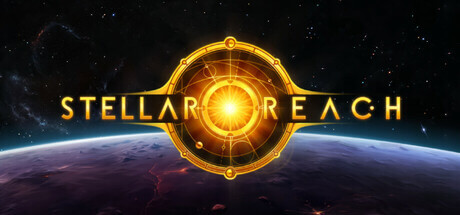Game: Stellar Reach
Genre: Strategy
System: Steam (Windows)
Developer|Publisher: Stelleas
Controller Support: No
Steam Deck: Playable
Price: US $19.99 | UK £16.75 | EU € 19.99
Release Date: October 22nd, 2025
Review code provided with many thanks to Game if You Are.
Stellar Reach – A Galactic Slow Burn
I’ll be honest right up front, Stellar Reach is not my usual type of game currently. It’s a deep, deliberate space strategy experience where menus, research queues, and long-term planning rule the stars. It’s a game that requires time and patience and is less easy to jump in and out of until you have learned its mechanics.
Once I settled in and gave Stellar Reach that time, something started to click. It’s a thoughtful, ambitious 4X strategy game about exploring, expanding and (occasionally) exterminating your way across the galaxy. The kind of game where your decisions ripple across light-years and where victory can be earned in several different ways.
This isn’t a casual ride through space. It’s more like learning to pilot a starship from scratch: daunting at first, rewarding once you’ve got your bearings.

Learning the Systems
Before the galaxy even opens up to you, Stellar Reach greets you with a chunky tutorial, and I mean chunky in the best way. It takes its time, slowly unlocking each feature, walking you through the dozens of interconnected systems that make up your empire. It almost feels like a campaign in itself, guiding you step by step rather than overwhelming you with flashing icons.
That said, the tutorial doesn’t explain everything brilliantly. There were times when I felt like I’d missed a memo, especially when trying to find specific fleets or planets. It took me a while to discover a few vital shortcuts, and there’s definitely room for streamlining navigation. Still, I appreciated that the tutorial never rushes you; it understands that this is a lot to take in.
When you start your proper campaign, you choose your faction, pick your rivals, set your difficulty, and get tossed into the deep black. From there, your goals are yours to define: expand peacefully, build a utopia of prosperity, become the galaxy’s biggest industrial powerhouse, or just go full space warlord and conquer everything. Guess it depends on what sort of week you had at work, which way you’ll choose.

Managing the Cosmos
At its core, Stellar Reach is about juggling. You’re managing colonies, sending out scouts to explore planets, balancing resources, and making long-term research decisions. Everything takes time, and I mean years in game terms. Researching new technologies, colonising planets, or sending fleets across systems is a slow, steady process. Luckily, you can fast-forward when you’re just waiting for something to finish.
Each choice you make feels important. Do you prioritise building fleets for protection, or invest in production to outpace your rivals later? Do you focus on prosperity, keeping your people happy, or push for industrial dominance to churn out ships faster? It’s this constant weighing of options that forms the backbone of the experience.
I especially liked the skill trees. As you progress, you can unlock perks, new ships, stronger weapons or faster research speeds. It’s satisfying to shape your faction’s growth based on your preferred playstyle.
However, as a newcomer to the genre, I did find Stellar Reach overwhelming at times. There are menus inside menus, and occasionally I’d lose track of what exactly needed attention. The UI can be a little dense, and I sometimes struggled to select specific fleets or planets when the map got crowded. It’s the kind of interface that rewards familiarity; you’ll get better at it the more you play, but it takes effort to get there. And something to keep in mind, there is a lot of stats and info to go through on screen. Heavenly to some players, but a possible hell in space for others.

Sound and Space
Visually, Stellar Reach keeps things minimal. You’re mostly staring at a galactic map dotted with planets, glowing lines, and ships represented as luminous silhouettes. It’s clean and functional but not exactly a visual showpiece. The real atmosphere comes from the music, and honestly, it’s fantastic.
The soundtrack deserves its own paragraph. It’s grand, sweeping, and cinematic, the sort of score that makes you feel like you’re about to embark on the final frontier. Even during slower stretches, I found myself just sitting there, letting the music fill the room while my empire quietly expanded. It gives Stellar Reach an emotional pulse that its visuals can’t always provide.

Conclusion: Stellar For the Right Player
Stellar Reach is the kind of strategy game that rewards commitment. It’s deep, deliberate, and brimming with systems to master. If you’re a fan of strategy or you love micromanaging every detail of your galactic empire, you’ll probably have a great time here.
Personally, I enjoyed it, but it’s not a game that fits neatly into my life right now. It demands focus, long sessions, and a bit of study. As a parent and serial multitasker, that’s a big ask! Still, I can absolutely see this being a new obsession for players who crave a complex, long-form strategy experience.
If you’re even slightly curious, I highly recommend trying the free demo first. It’ll tell you everything you need to know about whether this universe is one you’ll want to rule, or one you’d rather just admire from afar.
Final Verdict: I Like it 
Do you like our content?
Subscribe to our daily news and never miss a review!



